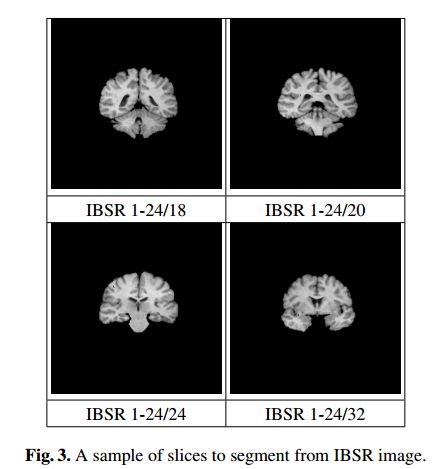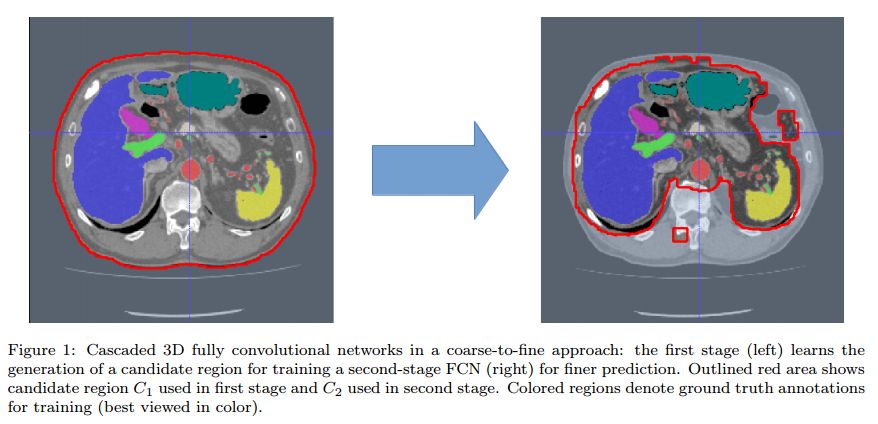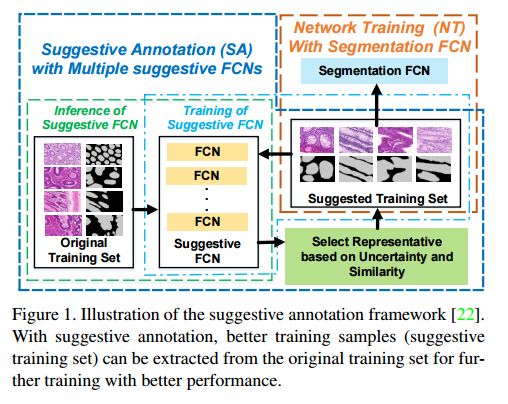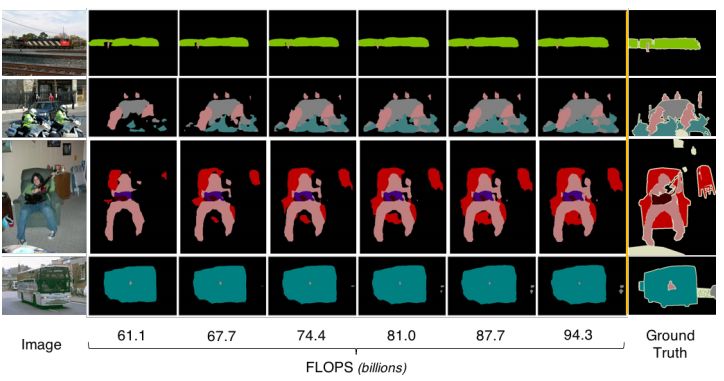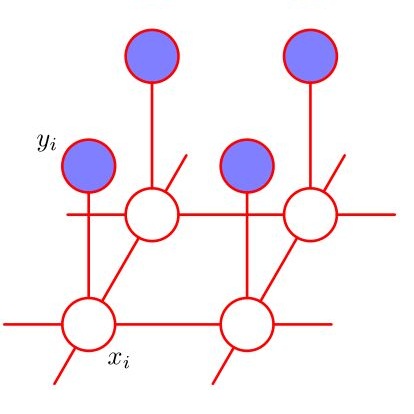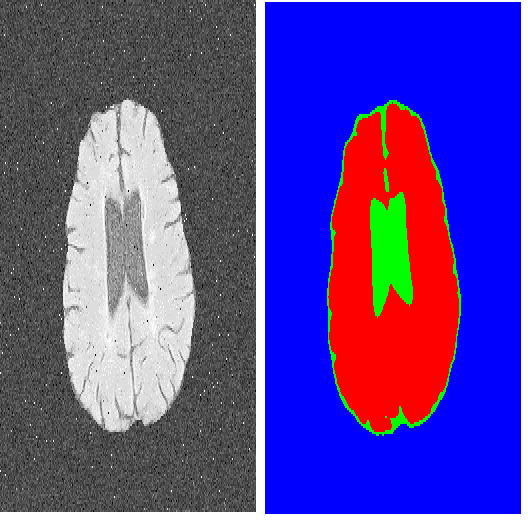【论文推荐】最新6篇图像分割相关论文—隐马尔可夫随机场、级联三维全卷积、信号处理、全卷积网络、多源域适应、循环分割
【导读】专知内容组整理了最近六篇图像分割(Image Segmentation)相关文章,为大家进行介绍,欢迎查看!
1.Combination of Hidden Markov Random Field and Conjugate Gradient for Brain Image Segmentation(基于隐马尔可夫随机场与共轭梯度结合的脑图像分割)
作者:EL-Hachemi Guerrout,Samy Ait-Aoudia,Dominique Michelucci,Ramdane Mahiou
机构:Universite de Bourgogne
摘要:Image segmentation is the process of partitioning the image into significant regions easier to analyze. Nowadays, segmentation has become a necessity in many practical medical imaging methods as locating tumors and diseases. Hidden Markov Random Field model is one of several techniques used in image segmentation. It provides an elegant way to model the segmentation process. This modeling leads to the minimization of an objective function. Conjugate Gradient algorithm (CG) is one of the best known optimization techniques. This paper proposes the use of the Conjugate Gradient algorithm (CG) for image segmentation, based on the Hidden Markov Random Field. Since derivatives are not available for this expression, finite differences are used in the CG algorithm to approximate the first derivative. The approach is evaluated using a number of publicly available images, where ground truth is known. The Dice Coefficient is used as an objective criterion to measure the quality of segmentation. The results show that the proposed CG approach compares favorably with other variants of Hidden Markov Random Field segmentation algorithms.
期刊:arXiv, 2018年3月13日
网址:
http://www.zhuanzhi.ai/document/0d1a98d3d681edc7ca62db9b980f4142
2. An application of cascaded 3D fully convolutional networks for medical image segmentation(应用级联三维全卷积网络进行医学图像分割)
作者:Holger R. Roth,Hirohisa Oda,Xiangrong Zhou,Natsuki Shimizu,Ying Yang,Yuichiro Hayashi,Masahiro Oda,Michitaka Fujiwara,Kazunari Misawa,Kensaku Mori
机构:Nagoya University
摘要:Recent advances in 3D fully convolutional networks (FCN) have made it feasible to produce dense voxel-wise predictions of volumetric images. In this work, we show that a multi-class 3D FCN trained on manually labeled CT scans of several anatomical structures (ranging from the large organs to thin vessels) can achieve competitive segmentation results, while avoiding the need for handcrafting features or training class-specific models. To this end, we propose a two-stage, coarse-to-fine approach that will first use a 3D FCN to roughly define a candidate region, which will then be used as input to a second 3D FCN. This reduces the number of voxels the second FCN has to classify to ~10% and allows it to focus on more detailed segmentation of the organs and vessels. We utilize training and validation sets consisting of 331 clinical CT images and test our models on a completely unseen data collection acquired at a different hospital that includes 150 CT scans, targeting three anatomical organs (liver, spleen, and pancreas). In challenging organs such as the pancreas, our cascaded approach improves the mean Dice score from 68.5 to 82.2%, achieving the highest reported average score on this dataset. We compare with a 2D FCN method on a separate dataset of 240 CT scans with 18 classes and achieve a significantly higher performance in small organs and vessels. Furthermore, we explore fine-tuning our models to different datasets. Our experiments illustrate the promise and robustness of current 3D FCN based semantic segmentation of medical images, achieving state-of-the-art results. Our code and trained models are available for download:
期刊:arXiv, 2018年3月14日
网址:
http://www.zhuanzhi.ai/document/19845e89c074ec47987dc62bb0e7938e
3.Signal Processing and Piecewise Convex Estimation(信号处理和分段凸估计)
作者:Kurt Riedel
机构:Huazhong University of Science and Technology,Wuhan University
摘要:Many problems on signal processing reduce to nonparametric function estimation. We propose a new methodology, piecewise convex fitting (PCF), and give a two-stage adaptive estimate. In the first stage, the number and location of the change points is estimated using strong smoothing. In the second stage, a constrained smoothing spline fit is performed with the smoothing level chosen to minimize the MSE. The imposed constraint is that a single change point occurs in a region about each empirical change point of the first-stage estimate. This constraint is equivalent to requiring that the third derivative of the second-stage estimate has a single sign in a small neighborhood about each first-stage change point. We sketch how PCF may be applied to signal recovery, instantaneous frequency estimation, surface reconstruction, image segmentation, spectral estimation and multivariate adaptive regression.
期刊:arXiv, 2018年3月14日
网址:
http://www.zhuanzhi.ai/document/91d316cb678222e8d15c8cb5963e6a85
4.Quantization of Fully Convolutional Networks for Accurate Biomedical Image Segmentation(用于精确的生物医学图像分割的全卷积网络的量化)
作者:Xiaowei Xu,Qing Lu,Yu Hu,Lin Yang,Sharon Hu,Danny Chen,Yiyu Shi
机构:Huazhong University of Science and Technology
摘要:With pervasive applications of medical imaging in health-care, biomedical image segmentation plays a central role in quantitative analysis, clinical diagno- sis, and medical intervention. Since manual anno- tation su ers limited reproducibility, arduous e orts, and excessive time, automatic segmentation is desired to process increasingly larger scale histopathological data. Recently, deep neural networks (DNNs), par- ticularly fully convolutional networks (FCNs), have been widely applied to biomedical image segmenta- tion, attaining much improved performance. At the same time, quantization of DNNs has become an ac- tive research topic, which aims to represent weights with less memory (precision) to considerably reduce memory and computation requirements of DNNs while maintaining acceptable accuracy. In this paper, we apply quantization techniques to FCNs for accurate biomedical image segmentation. Unlike existing litera- ture on quantization which primarily targets memory and computation complexity reduction, we apply quan- tization as a method to reduce over tting in FCNs for better accuracy. Speci cally, we focus on a state-of- the-art segmentation framework, suggestive annotation [22], which judiciously extracts representative annota- tion samples from the original training dataset, obtain- ing an e ective small-sized balanced training dataset. We develop two new quantization processes for this framework: (1) suggestive annotation with quantiza- tion for highly representative training samples, and (2) network training with quantization for high accuracy. Extensive experiments on the MICCAI Gland dataset show that both quantization processes can improve the segmentation performance, and our proposed method exceeds the current state-of-the-art performance by up to 1%. In addition, our method has a reduction of up to 6.4x on memory usage.
期刊:arXiv, 2018年3月14日
网址:
http://www.zhuanzhi.ai/document/45bf1ceea64b602cf1aecdc4c2b14a3c
5.Optimal Transport for Multi-source Domain Adaptation under Target Shift(目标转移下多源域适应的最优传输)
作者:Ievgen Redko,Nicolas Courty,Rémi Flamary,Devis Tuia
摘要:In this paper, we propose to tackle the problem of reducing discrepancies between multiple domains referred to as multi-source domain adaptation and consider it under the target shift assumption: in all domains we aim to solve a classification problem with the same output classes, but with labels' proportions differing across them. We design a method based on optimal transport, a theory that is gaining momentum to tackle adaptation problems in machine learning due to its efficiency in aligning probability distributions. Our method performs multi-source adaptation and target shift correction simultaneously by learning the class probabilities of the unlabeled target sample and the coupling allowing to align two (or more) probability distributions. Experiments on both synthetic and real-world data related to satellite image segmentation task show the superiority of the proposed method over the state-of-the-art.
期刊:arXiv, 2018年3月13日
网址:
http://www.zhuanzhi.ai/document/d142a1ab75dd434121e2b8efae2aaebc
6. Recurrent Segmentation for Variable Computational Budgets(可变计算预算的循环分割方法)
作者:Lane McIntosh,Niru Maheswaranathan,David Sussillo,Jonathon Shlens
机构:Stanford University,Google Brain
摘要:State-of-the-art systems for semantic image segmentation use feed-forward pipelines with fixed computational costs. Building an image segmentation system that works across a range of computational budgets is challenging and time-intensive as new architectures must be designed and trained for every computational setting. To address this problem we develop a recurrent neural network that successively improves prediction quality with each iteration. Importantly, the RNN may be deployed across a range of computational budgets by merely running the model for a variable number of iterations. We find that this architecture is uniquely suited for efficiently segmenting videos. By exploiting the segmentation of past frames, the RNN can perform video segmentation at similar quality but reduced computational cost compared to state-of-the-art image segmentation methods. When applied to static images in the PASCAL VOC 2012 and Cityscapes segmentation datasets, the RNN traces out a speed-accuracy curve that saturates near the performance of state-of-the-art segmentation methods.
期刊:arXiv, 2018年3月15日
网址:
http://www.zhuanzhi.ai/document/15ff5ea006e468c8988135e2d42dbfef
-END-
专 · 知
人工智能领域主题知识资料查看获取:【专知荟萃】人工智能领域26个主题知识资料全集(入门/进阶/论文/综述/视频/专家等)
同时欢迎各位用户进行专知投稿,详情请点击:
【诚邀】专知诚挚邀请各位专业者加入AI创作者计划!了解使用专知!
请PC登录www.zhuanzhi.ai或者点击阅读原文,注册登录专知,获取更多AI知识资料!
请扫一扫如下二维码关注我们的公众号,获取人工智能的专业知识!
请加专知小助手微信(Rancho_Fang),加入专知主题人工智能群交流!加入专知主题群(请备注主题类型:AI、NLP、CV、 KG等)交流~
点击“阅读原文”,使用专知!
